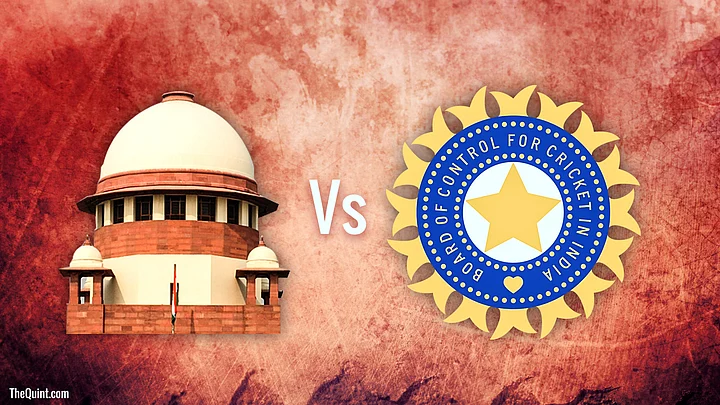The BCCI issue is a drama that does not seem to end. It is the television serial that drags on, stretching like some magic elastic to test the patience of everyone. After a while you just want someone to step forward and pull the plug - and announce 'The End'.
Its has been over 14 months since the Supreme Court made it pronouncement in the Lodha-BCCI matter, but it’s nowhere close to a resolution now, than it was back then. With the next hearing scheduled for October 30 this is turning out to be a timeless test, a play-to-finish match without a time limit.
While many are losing hope, and interest, the comedy and tragedy involved in the drama can't be ignored. The tragedy is that the dysfunctional state of the BCCI hurts Indian cricket and cricketers deeply. This season itself, the sport has scored spectacular self goals (most recent being the Duleep Trophy fiasco) and without clarity about who is in control, the road ahead can only be bumpy. The comedy is the continuing back and forth over the new Constitution of the cricket body.
First, BCCI had their own version, then the Lodha Committee stepped in and made a new one which was approved by the Supreme Court. Then the COA made one more. The current update is that the Supreme Court has asked the BCCI for inputs
So, what next?
So far the entire narrative of the BCCI’s Constitutional changes has focussed only on a few big points that have been the the main areas of conflict between the BCCI and the CoA, namely age and tenure of officials and the voting rights of State Associations. But the draft constitution has many far reaching clauses which make this a game changing document. Its small print has slipped under the radar but the new constitution effectively democratises cricket by putting the onus on stakeholders.
Overall Guiding Principle: More Governance, Less Officials
Officials lose big in this reboot, their powers are reduced, roles shrunk and patronage taken away. With this, kings become commoners, and as happened with the entitled, this is the privy purse moment when privileges end.
The running of cricket moves away from officials with most BCCI committees scrapped or merged.
One example: Now on, selectors will appoint Team India coach and support staff. Hence (as happened during the Kumble-Shastri case) no controversies over applications, fresh applications, legends making recommendations and appointing people by overreaching their brief, candidates alleging 'setting'.
Another example: The draft Constitution proposes a talent development committee (consisting of 3 players) to supervise National Cricket Academy, infrastructure and zonal coaching camps.

BCCI Role Expanded
Till now the BCCI's stated objective was to promote and develop the sport in India. Earlier the Constitution's scope was limited to internal processes , now the canvas is much wider. The new constitution expands the role of the BCCI and for the first time lists its responsibilities and obligations. Like a 35 mm film blown up to 70, the new BCCI is positioned as a robust contemporary organisation.
Prominence to Players
Players get a major portfolio in the cabinet reshuffle. According to the new Constitution, players are critical stakeholders with a larger role and greater voice in the sport’s administration.
Some instances of how power will move to the players:
- Player representation in the Apex Council that replaces the existing Working Committee.
- Formation, and recognition, of a Players Association to put forward their perspective on issues.
- The BCCI is committed to player welfare measures, support needy players in difficult times and look after families of players in distress.

Importance to Fans
Besides players, fans too find prominent mentions in the new constitution and are given certain rights. Till now the 'fan first' policy of the BCCI was only a convenient slogan, almost like an election promise which is regularly invoked but not implemented. The new constitution changes this by including clauses directly benefitting fans. A few are stated below:
- Ticket sales of International matches have to announced sufficiently in advance, rates should be reasonable.
- Adequate arrangements to be made during a match for wash rooms, drinking water, parking, ramps.
- Stadium capacity has to be announced, all seats should be numbered.
- Not more than 10% tickets to be given free of charge.
- All details of free tickets passed around to be uploaded on the website.
Once the Constitution is accepted, these clauses become the responsibility/duty of officials, and rights of fans/spectators. Significantly, to ensure these provisions don't remain hollow intent, any aggrieved person can approach the court for redressal citing failure to discharge duty. The constitution has even created a mechanism, under the Ombudsman and an Ethics officer, for dispute resolution and addressing complaints.

Cricket to Engage with Society
The new constitution lays down the road map by stating cricket must engage and contribute to society instead of living in an isolated bubble. Going forward, the BCCI must contribute to charity and connect with youngsters. In another significant provision, the constitution provides for cricket to support and assist other sports, and even grant scholarships to non cricket athletes.

Focus on Openness and Transparency, Mantra of Good Governance
The new constitution transfers power away from officials and towards players and fans. It also changes the rules of engagement by putting in systems to prevent abuse/misuse of authority. In a way this is a clever inswinging yorker that appears to be a harmless half volley but slips under the bat of unsuspecting batsmen!
(At The Quint, we question everything. Play an active role in shaping our journalism by becoming a member today.)
